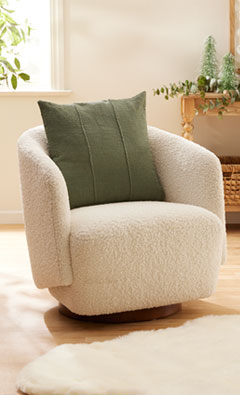Delivery and Pick Up
Clear Etched Flower Glass Vase
Tan Ceramic Abstract Tilt Vase

White Ceramic Fluted Long Neck Vase
Blue and Pink Stripe Glass Cylinder Vase
Brown Ceramic Ribbed Bud Vase
64 of 64 Items
Vases: Types, Styles, and Care
Vases have been used for centuries as vessels for holding flowers and other home decor. They're a staple in interior design, adding color, texture, and personality to shelves and tabletops. Let's explore the different types and styles of vases, and give you some tips for vase care and maintenance.
Types of Vases
Each kind of vase available has its own unique advantages. Here are some of the most common types:
Ceramic Vases
- Advantages: durable; versatile
- Disadvantages: can be heavy; easily breakable
- Examples: reactive-glaze ceramic vases, handcrafted pottery vases, terracotta vases
Glass Vases
- Advantages: refined and elegant; the beauty of flowers shines through
- Disadvantages: fragile; prone to breaking
- Examples: bud vases, recycled glass vases, colored glass vases
Metal Vases
- Advantages: durable and sturdy; come in many textures and aesthetics
- Disadvantages: can be heavy; prone to tarnishing
- Examples: hammered metal vases, antiqued vintage metal vases
Wood Vases
- Advantages: warm and natural; has an artisan vase look
- Disadvantages: not watertight; mostly suitable for dried and faux flowers
- Examples: hand-carved wood vases, turned wood vases
Styles of Vases
Vases also come in different shapes and styles to match any design aesthetic from farmhouse to contemporary:
Traditional Vases
- Characteristics: classic shapes and patterns; often with intricate hand-painted designs
- Examples: metal or ceramic urn vases; chinoiserie or ginger jar vases
Contemporary Vases
- Characteristics: sleek and modern; often with abstract designs
- Examples: geometric vases; minimalist vases; asymmetrical vases
Rustic Vases
- Characteristics: natural materials; earthy colors; organic shapes
- Examples: wooden vases, textured ceramic vases; distressed pottery-style vases
Minimalistic Vases
- Characteristics: simple and understated; often monochromatic
- Examples: white ceramic vases; single stem vases; test tube vases
Decorative Vases
- Characteristics: ornate and decorative even without flowers; bold patterns or shapes that aren't typical of vases
- Examples: hand-painted vases; bust vases; female figure vases
Vase Care and Maintenance
To keep your vases in tip-top shape, it's easy to take care of them with these maintenance tips:
Cleaning Tips
- Use a soft cloth or sponge on the exterior
- For tough stains or interior smells, mix warm water with dish soap and scrub gently
- Avoid using harsh chemicals or abrasive materials that could scratch the surface of the vase
Water and Flower Care
- Change the water in your vase every few days to prevent bacteria growth
- Cut the stems of fresh flowers at an angle to help them better absorb water
- Remove any leaves that are submerged in water to prevent decay
Display Tips
- Consider the size and shape of the vase in relation to the shelf or tabletop on which it's placed
- Group vases together in odd numbers for a more visually appealing display
When selecting the perfect vase, consider the type of material and style that best matches your unique decor taste. If you take care of your new addition properly, your vase will continue to bring joy and beauty to your home for years to come.






